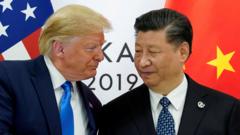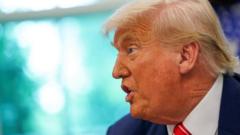As NATO prepares for its upcoming summit, the Alliance’s Secretary General, Mark Rutte, is seeking to turn back the clock on some of the tensions caused by former President Trump's insistence on increased defense spending from U.S. allies. With memories of Trump's 2016 criticisms still fresh, Rutte has proposed that member nations raise their defense spending targets to 5% of GDP—significantly higher than the current goal of 2%. This proposal aims to show goodwill towards the U.S. while addressing the perception that some European countries aren't contributing their fair share.
NATO's 5% Defense Spending Proposal: A Bid to Please Trump

NATO's 5% Defense Spending Proposal: A Bid to Please Trump
NATO's chief proposes a substantial increase in defense spending, echoing demands from former President Trump.
During a press conference held in Brussels, Rutte laid out his plans, stating that the increase aims to enhance NATO’s collective strength while possibly appeasing the U.S. The proposed financial commitment is designed so that 3.5% would come from core defense spending, while the remaining 1.5% could be labeled as “defense-related expenditures,” including infrastructure and industrial costs. This terminology provides NATO members some leeway in meeting the targets.
Despite elevating the discussion, the commitment from member nations remains uncertain. Rutte acknowledged the challenges, emphasizing the need for a "cunning plan" to hold leaders accountable for maintaining steady annual progress towards this ambitious goal over an estimated 10-year timeline. As it stands, many members still struggle to meet the existing 2% spending target set years ago.
Next week, Rutte will visit the UK to discuss the implications for Prime Minister Sir Keir Starmer, as the UK's current pledge falls short of the new proposed levels. In addressing reporters, U.S. Defense Secretary Pete Hegseth voiced optimism about a collective push towards the 5% target, indicating that nations like France and Germany have already signaled commitment.
As NATO heads into this new chapter, all eyes will be on whether its members can rise to the occasion and deliver on this bold spending initiative.
Sources include Reuters and other news agencies.
Despite elevating the discussion, the commitment from member nations remains uncertain. Rutte acknowledged the challenges, emphasizing the need for a "cunning plan" to hold leaders accountable for maintaining steady annual progress towards this ambitious goal over an estimated 10-year timeline. As it stands, many members still struggle to meet the existing 2% spending target set years ago.
Next week, Rutte will visit the UK to discuss the implications for Prime Minister Sir Keir Starmer, as the UK's current pledge falls short of the new proposed levels. In addressing reporters, U.S. Defense Secretary Pete Hegseth voiced optimism about a collective push towards the 5% target, indicating that nations like France and Germany have already signaled commitment.
As NATO heads into this new chapter, all eyes will be on whether its members can rise to the occasion and deliver on this bold spending initiative.
Sources include Reuters and other news agencies.



















